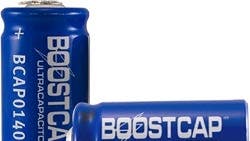C-Cell Ultracaps Offer New Options for Packaging, Performance, and Cost
With the introduction of its C-cell ultracapacitors, Maxwell Technologies once again exploits a popular battery package—this time to reduce cost versus performance for components in the 100-F range. The new ultra-caps use the same proprietary electrode material applied in the previously introduced D-cell ultracapacitors. However, the smaller C-cells also offer designers the option of selecting cells that have been optimized for either power delivery or energy storage (see the figure below).
The BCAP0120 P250 is a 120-F power-type C-cell engineered specifically for high-cycling applications that require the lowest ESR and highest efficiency. This ultracap features a power density of 21.5 kW/kg. Other specifications include an ESR of 5.0 Ω and a time constant of 0.6 sec.
The BCAP0140 E250 is a 140-F energy version designed to provide more economical solutions for lighter duty applications. This ultracap provides an energy density of 4.4 Wh/kg and a power density of 14.9 kW/kg. Meanwhile, the ESR of this part is 7.2 Ω and its time constant is 1.0 sec.
Both the power and energy models are also available in a fully integrated six-cell, 15-V pack. The C-Cell ultracapacitor cells and multi-cell packs provide high-performance, "life-of-the system" alternatives to batteries for a range of industrial and transportation applications. These include industrial robotics, actuators, telecom power buffering and back-up, aircraft door and air bag actuation, distributed power nodes for automotive subsystems and solar energy system augmentation.
These 2.5-V cells have the same external dimensions but one-third the weight (29 g) of the familiar C-size battery. Moreover, the cells are designed for easy mounting on PCBs and in other electrical devices and systems.
In developing the C-Cells, Maxwell Technologies aimed to replace its PC100E series ultracaps with lower-cost models. The cost reduction is made possible in part by the use of the company’s carbon-powder-based electrode, which enables better performance-versus-cost than the carbon cloth material electrode employed in the PC100E. The C-Cells are said to offer a 4- to 5-times reduction in cost per Farad versus the PC100E series.
The C-cell ultracapacitors are currently undergoing UL testing and UL approval is anticipated in the next few months. For more information, see www.maxwell.com.
